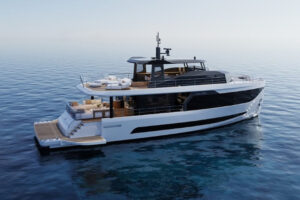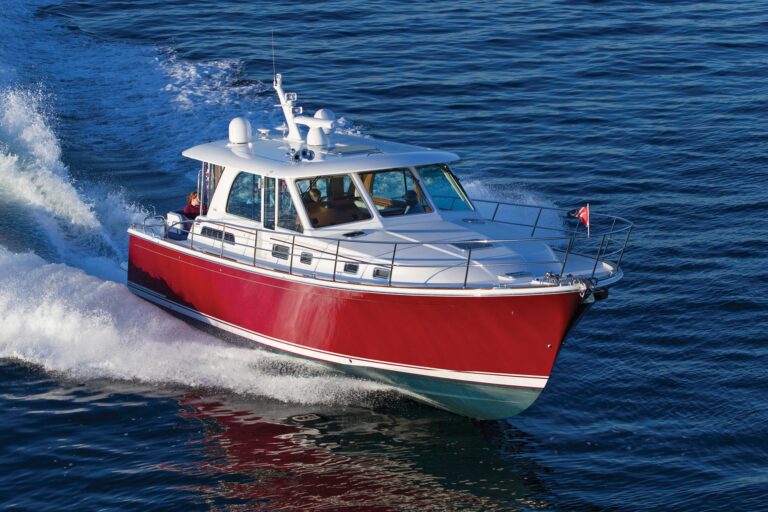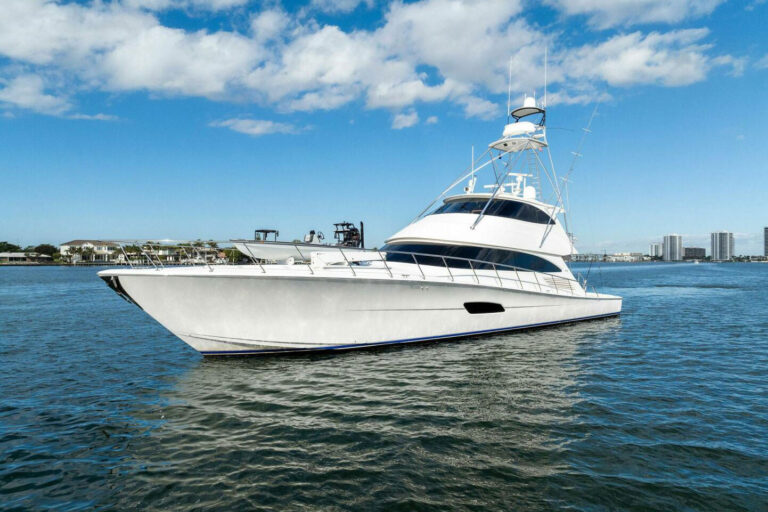The hand of Maytag agitated the waters off Bass Harbor, Maine, as we gingerly made our way from the dock at Morris Yachts to hull number two of the 52 raised-saloon cruising sloop Far Out. A seamless mantle of cloud wore the color of pewter, which we saw reflected off the dancing water. A tinge of green, the one so popular with rocks at low tide, tinted the water a color that reminded me of UFL (unidentified flowing liquid) common to the gutters of Manhattan. The wind blew 15 to 20 knots, scattering the occasional raindrops like bits of chaff at harvest time. We were going to have a grand sail.
This was June, Down East on Mount Desert Island, and I loved it. The conditions were tailor-made for sea trials aboard a cruising boat designed and built for fast passagemaking offshore.
Chuck Paine, who has been designing boats for Morris since dirt was invented, derived the 52 from a 50 he drew nearly 10 years ago. Taking from that gene pool is not a bad thing, because the 50 was a fast and seakindly cruiser. Paine extended the sailing length by adding to the stern. He also added a bit of height to the topsides to increase the interior volume and headroom. Then, to give the new 52 a current Morris identity, Paine designed a totally new deck and house. The result is a handsome, conservative yacht that should stand the test of time and hold a healthy resale value.
“Conservative is also an apt description for the Morris 52 below the waterline. Paine struck a fine compromise among the conflicting criteria that go into the bottom of any sailing yacht. Every designer has to juggle beam, cross-sectional shape (referred to as sections or as a body plan), waterlines and buttocks to get the handling characteristics he wants. Beam at DWL on the 52 is moderate by the standards of offshore racing boats, but is greater than was common, say, 10 years ago in cruising boats. The greater the beam, the more form stability the hull has.
A relatively hard turn at the bilges also enhances form stability, up to a certain angle of heel, at which point many other factors enter the picture. The Vendee Globe boats are a perfect example of form stability in the extreme. The amidships sections of Paine’s recent hulls are a compressed semicircle, as though someone pulled each end of a semicircle and caused its bottom to rise off the baseline. In addition to aiding form stability, sections of this shape give the yacht fair waterlines when she heels. Fair waterlines generally prevent evil steering characteristics throughout the range of heeling angles.
Sailing yachts need balanced ends to perform well in the greatest variety of conditions. The best designers seem to have a nearly supernatural ability to get this correct, and most of them will tell you that science takes them only so far. Paine is convinced that hollow in the waterlines at the bow improves speed and handling traits, so the 52 has hollow sections forward-not extreme, but definitely noticeable. A hollow entry lets the bow slice through the water to ease the initial impact of the waves. The increase in buoyancy as the hull broadens toward maximum beam at DWL gently lifts the bow over the body of each wave.
Back aft, a good cruising yacht wants enough bearing to support a crowd in the cockpit, stuff in the lazarettes and, in this yacht, the master stateroom. A generous surfing area is another benefit of carrying aft a large percentage of the yacht’s maximum beam. Boats of this type have a “powerful stern, according to the jargon of the sailing game.
For a cruising yacht, the Morris 52 has a shallow canoe body, though not as shallow as the builder’s racier models. Combined with light weight, the shallow hull encourages a sailing yacht to surf on the face of waves and to generally exceed the old-fashioned 1.34 speed/length ratio. If the designer can make the yacht stable enough to stand up under a large rig, he’ll achieve sail area/wetted-surface and sail area/displacement ratios that permit high top speeds with exceptional light-air performance. Paine found a reasonable compromise over the entire range. I wouldn’t toss the auxiliary, but I’ll wager the owner won’t have to use it much if he doesn’t want to.
Aboard Far Out, the crew prepared to cast away the mooring pennant while I went below to look around. I felt as though I were violating consecrated territory as I left wet footprints on the companionway stairs. The accommodations of this 52 positively glow with glossy varnish. The term “overdone seemed an appropriate description from my point of view, but the owners love it.
Morris does the best nonslip surface on its companionway stairs. Tom Morris said it’s simply white sand set in the normal varnish. It functioned as it should under my wet sea boots. The varnished teak-and-pear cabin sole, however, rejected my wet boots as though they were incompatible organs. A nonslip surface on the cabin soles may not be pretty, but neither are cuts and bruises on the bodies of crew members who’ve skated into the furniture. The strategically placed handrails ought to help.
Every Morris yacht is custom, so the owner has a nearly unlimited choice of arrangement plans. Far Out’s arrangement plan is straightforward and useful. The owners wisely chose to have the two large staterooms at opposite ends of the boat, separated by the common area. This level of privacy aboard a small yacht promotes peace and good times. Although a husband and wife easily manage Far Out, they could sail with a crew of two professionals, accommodated in the guest cabin on the port side opposite the galley. These berths are great for off-watch crew to sleep during long passages. If this were my boat, I’d have requested a work/utility room in place of the over/under guest cabin. This would let me close off the galley at its after end and place the passageway to and from the master stateroom on the port side.
I made my way topside when I felt Far Out accelerate under auxiliary power. Although the engine is under the sink in the galley, careful attention to sound attenuation makes its presence less than annoying for occupants of the saloon.
After we cleared the mooring field, we headed into the wind and hoisted the main to the first reef point. We fell off a bit on starboard tack and unrolled the 100-percent foretriangle. This small jib hoists to the masthead buy doesn’t overlap the main. Although a crew member has to handle the jib sheet during tacks and jibes, careful timing precludes the need for the primary winches.
Far Out has the taller of two rigs offered with the 52. The rig of hull number one was less than 65 feet above DWL so it could clear the fixed bridges on the Intracoastal Waterway. The mast aboard Far Out stretches to 67 feet above DWL. Although the difference in sail area between the two rigs isn’t great, it’s at the top where the breeze is often stronger than it is at deck level. This seems to be especially true in light air.
We didn’t have to think about light air during my sea trial. Under reefed main and full jib, Far Out accelerated in a flash to her theoretical hull speed of 9 knots at about 30 degrees to the apparent wind. Although we didn’t encounter any waves long enough for surfing, the 52 readily exceeded 9 knots close reaching down the face of the existing waves.
On all points of sail, the steering remained accurate and easy, providing all the tactile sensation a good unassisted system should. I always knew what the rudder was doing. Every one of Paine’s designs I’ve sailed balances so well you’d think an autopilot was an extravagance. This was true of Far Out. On any point above a beam reach, I could leave the helm unattended for a minute or more before she began to creep slowly into the wind. If I had to endure a hard chance, I’d want my boat to behave as well as this Morris 52.
Exceptional workmanship in the laminate and the joinerwork, comfort and safety under way, and timeless good looks make Morris yachts a good value for the long term. Far Out ought to please her owners for many years to come.
Contact: Morris Yachts, (207) 244-5509; sales@morrisyachts.com; www.morrisyachts.com.








